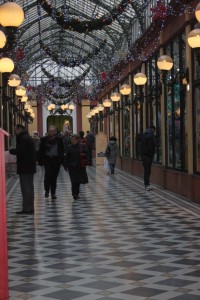In the 19th century, passages were developed to enable shoppers to escape the rain and mud that was flung up from the horse drawn carriages. Giving the shoppers a pleasant shopping experience. In much the same way that we now have shopping centres.
The shopper could arrive at the passage, have their shoes dusted, step down from their carriage, directly into the passage and shop, all under one roof and away from the elements.
It seemed only fitting that I visit some of these passages today, as it was a blustery, gusty, rainy day. Umbrellas were forced inside out, menu boards were sent flying down the street and awnings over the restaurants were fiercely flapping, as the wind built up momentum.
When I am in Paris, I prefer to walk, irrelevant of the weather, otherwise, I am afraid I may miss something. Today I discovered that the end of my street turns into a passage way of sorts, cobbled and beautiful. So I braved the weather and headed for the 2nd arrondissement, with 16 passages to discover!
This is irony for you, with the cold wind and rain blowing in my face and my cheap umbrella spending more time convexed instead of concaved, I arrived at Passage des Princes, just as the rain stopped and the sky opened up.
Baron Haussmann gave Paris it’s beautiful wide sweeping boulevards but sadly, many passages were demolished, in the process. Once there was around 140 passages, in central Paris. Today only around 20 are left.
Although they were starting to go out of fashion, Passage des Princes, was the last to be built.
Beautifully restored and now dedicated to toys.
Next stop was Passage Verdeau, with antiques and books.
The Verdeau passage continues on to become the passages of the Panoramas and Jouffroy. Both Verdeau and Jouffroy were built in 1846.
Passage Jouffrey, was the first passage to be built entirely from metal and glass.
Passage Jouffrey has a weird and curious shop that looks like it stepped straight out of the pages of Harry Potter
Across the street, one of the first passages to be built Passage Panoramas. Opened in 1800, boasts one of the first places to have gas lighting in Paris. .
In the 1830’s the gallerie was renovated and three more passages were added.
Next Passage de Choiseul – opened in 1827.
Then on to the magnificent Gallerie Vivienne built in 1823, wonderful mosaic floors, glass roof and elegant detail. Jean-Paul Gaultier has a shop here.
Next a very quaint, secret passage way
Galerie Verot-Dodat is simply gorgeous.
In 1826, two investors, the porkbutcher Benoit Véro and the financier, Dodat, built this passage between the streets of Bouloi and Jean-Jacques-Rousseau.
There is no guessing, what the brand of the wonderful shoe store in this passage is. For the price of an apartment in Paris for a month, I could have had a pair of snake skin boots with the signature red soles.
Or these, displayed in a glass dome!
The light was fading and I needed to get back to the apartment to get ready for a concert, later in the evening. So the passage discovery had to end for now. I think I was being very optimistic, thinking I would see 16 passages in one day but I did manage to see half of them.
The last was Passage Bourg L’Abbe, built in 1828 and was much larger than it is today.
The links for the passages are in french with the address.

























3 Responses to Passages of Time